Webinar Takeaways: Revisiting The Lockdown—New Strategies Your Business Should Take To Get Workers Vaccinated & Tackle New COVID Laws
It has been a year since the global coronavirus pandemic caused the world to hit pause, and as we slowly make our way out of the lockdown, it’s crucial that waste and recycling businesses understand federal and state guidelines and restrictions as well as COVID-19 vaccine distribution for essential industry workers.
To better understand this important information, Adele L. Abrams, Esq., CMSP, firm president of the Law Office of Adele L. Abrams P.C.; Kirk Sander, chief of staff and vice president of safety and standards for the National Waste & Recycling Association (NWRA); and Jim Riley, chief counsel and senior vice president, government affairs for NWRA, outlined how we can start getting our industry back to “normal” in a recent webinar entitled “Revisiting The Lockdown: New Strategies Your Business Should Take To Get Workers Vaccinated & Tackle New COVID Laws.”
Kicking off the webinar, Abrams explained that the federal guidance produced by the Occupational Safety and Health Administration (OSHA) has changed over the past year, mainly due to lawsuits calling for emergency temporary standards, some congressional hearings and the recent change in administration.
“The first order of business for the new administration was COVID-19, and, in particular, how workplaces were going to be impacted by this with respect to OSHA enforcement,” she said during the webinar.
While there was some conflicting federal guidance from OSHA in 2020, President Biden signed an Executive Order in January 2021 directing regulators to issue stronger guidance for workplaces and asked the Department of Labor to clarify that “workers have a federally guaranteed right to refuse employment that will jeopardize their health, and if they do so, they will still qualify for unemployment insurance.”
In response to the Executive Order, OSHA reviewed enforcement efforts and identified changes that can better protect workers and ensure “equity” in enforcement; launched a national emphasis program focusing on violations putting the largest number of workers at risk; and started coordinating a multilingual outreach campaign with multiple stakeholders. More specifically, OSHA released three new documents on how it can enforce against employers that are not managing COVID-19 appropriately at the federal level—the Employer Compliance Guidance, the COVID-19 National Emphasis Program (NEP) and the Updated Interim Enforcement Response Plan for Coronavirus Disease 2019 (COVID-19). OSHA is also considering an emergency temporary standard, which was supposed to be announced by March 15 but is now expected to be announced at a later, undetermined date.
On the state OSHA level, four states—California, Michigan, Oregon and Virginia—have issued emergency temporary or permanent COVID-19-related standards, and more than 14 states have adopted some form of worker safety protections in addition to separate executive orders requiring face masks in the workplace, which have been issued by some governors.
Employer Compliance Guidance
In January, OSHA released this guidance for planning purposes and stated that the guidance should be used by employers and employees to “help identify risks of being exposed to and of contracting COVID-19 in workplace settings and to determine any appropriate control measures to implement.”
The guidance includes information on COVID-19, face coverings, COVID-19 prevention plans, COVID-19 protections in the workplace, the role of employers and employees in responding to COVID-19, limiting the spread of COVID-19, physical distancing, ventilation systems, personal protection equipment (PPE), cleaning and disinfecting, good hygiene practices and more.
COVID-19 National Emphasis Program
NEP, which was announced on March 12 and aims to significantly reduce or eliminate workers’ exposure to COVID-19, includes criteria to identify “high hazard industries” targeted for enforcement and compliance actions. This program can be amended, extended or canceled depending on the state of the pandemic and the information available.
“We don’t know what we don’t know, but we’re starting to learn what wasn’t really necessary, such as cleaning mail and groceries,” said Abrams. “We’re still evolving our knowledge base, and OSHA and employers need to be fluid and on top of information.”
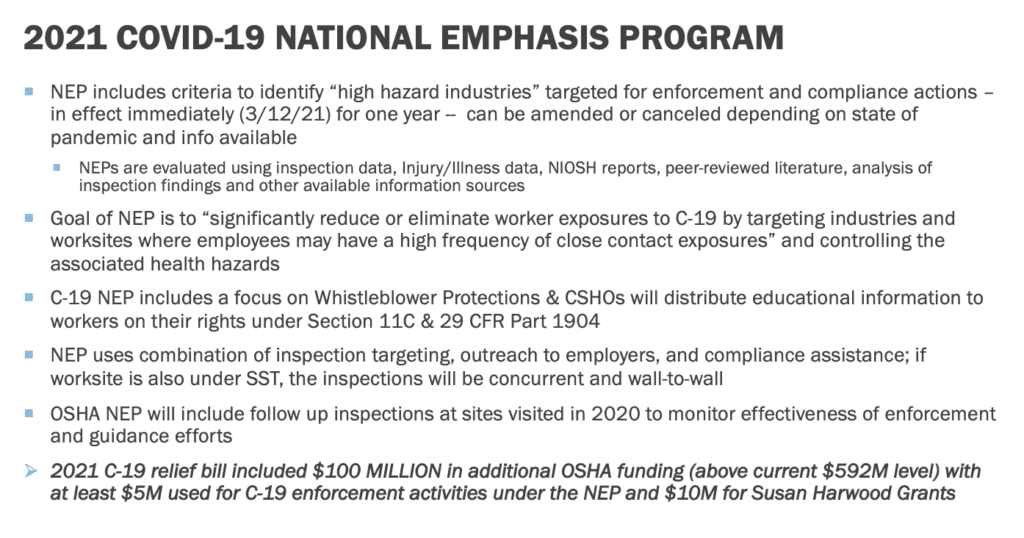
NEP uses a combination of inspection targeting, outreach to employers and compliance assistance. The inspections focus on verifying that employers are taking correct actions to protect workers from COVID-19 and augments non-programmed activities such as follow-up inspections on complaints, referrals and severe incident reports.
“Before an onsite inspection, CSHOs [compliance safety and health officers] are advised to determine if an employer has a written safety and health plan for contingences for emergencies such as COVID; procedures for hazard assessment; protocols for PPE, physical distancing and face coverings; medical records related to worker exposure incidents or other incidents deemed appropriate and related to COVID-19 by the inspector, etc.,” explained Abrams. “This information provides a roadmap for the walkaround inspection.”
NEP currently only applies to the certain establishments listed below, but Abrams advises businesses to review their customer base and identify any customers that may fall under these NAICS codes as other businesses and workers could be subject to citation if they are onsite during an inspection.
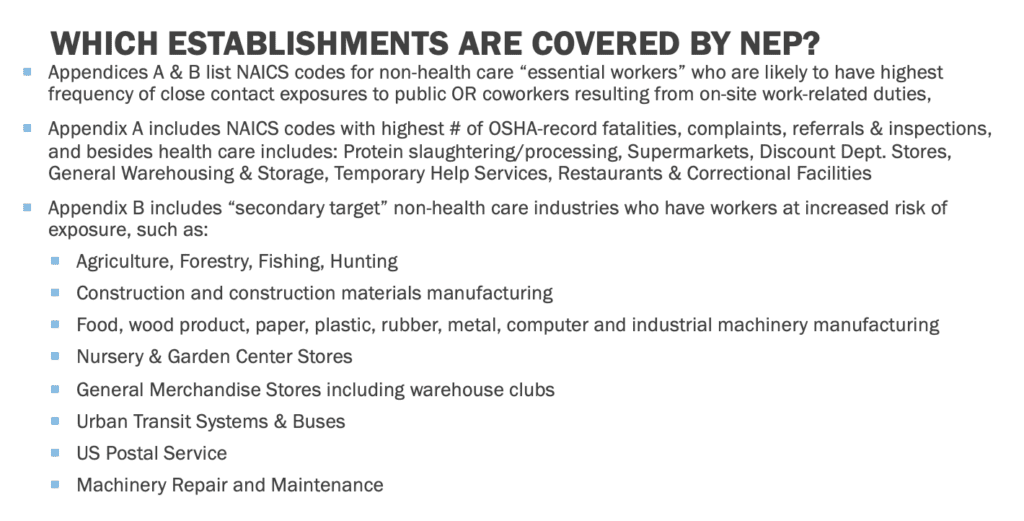
Updated Interim Enforcement Response Plan for Coronavirus Disease 2019 (COVID-19)
The Updated Interim Enforcement Response Plan for Coronavirus Disease 2019 (COVID-19), also released on March 12, includes new instructions and guidance to area offices and CSHOs for handling COVID-19-related complaints, referrals and severe illness reports. According to the document, “the guidance is intended to be time-limited to the current COVID-19 public health crisis … and OSHA’s priority is to use its resources to eliminate and control workplace exposures to SARS-CoV-2 (severe acute respiratory syndrome coronavirus 2), the cause of COVID-19, and to provide OSHA enforcement personnel with the protections necessary to allow them to safely perform inspections.”
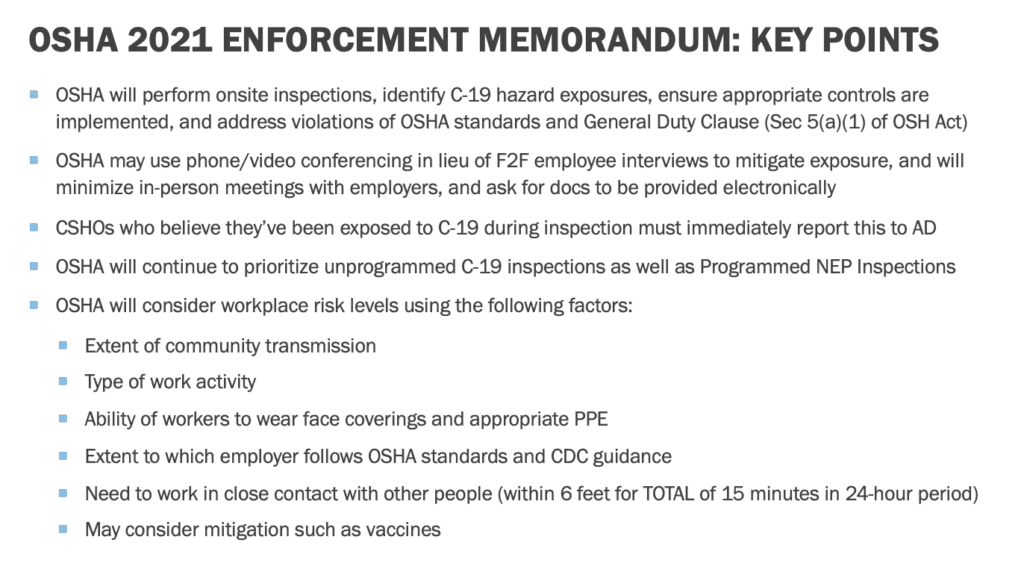
In regard to reporting and recording, businesses are advised to look at both federal and state guidance as this information can vary. Federal guidance states that employers are responsible for recording work-related cases of COVID-19 illness on their Form 300 logs if the following requirements are met: the case is a confirmed case of COVID-19 as defined by the Centers for Disease Control and Prevention; the case is work-related (as defined by 29 CFR 1904.5); and the case involves one or more relevant recording criteria (set forth in 29 CFR 1904.7).
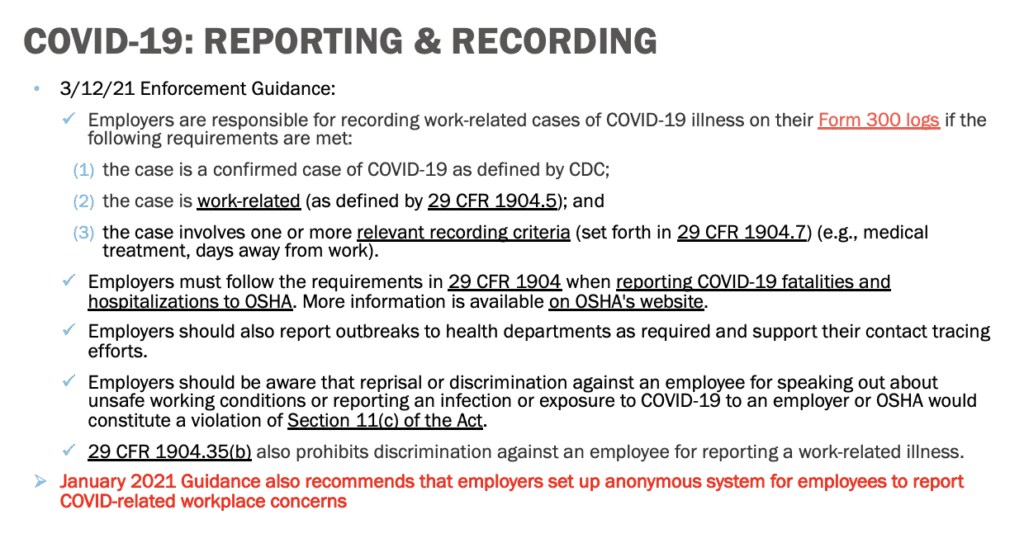
While there are federal requirements around reporting and recording, federal OSHA currently does not require employers to notify other employees if one of their coworkers gets COVID-19. However, employers must take appropriate steps to protect other workers, such as cleaning and disinfecting the work environment, notifying other workers to monitor themselves for signs/symptoms of COVID-19 or implementing a screening program in the workplace.
In regard to vaccines, employers can only encourage (not require) workers to get vaccines as federal regulations say you can’t force someone to get an emergency vaccination. Currently, the vaccines only have clearance from the United States Food and Drug Administration, and the eligibility for vaccines varies from state to state.
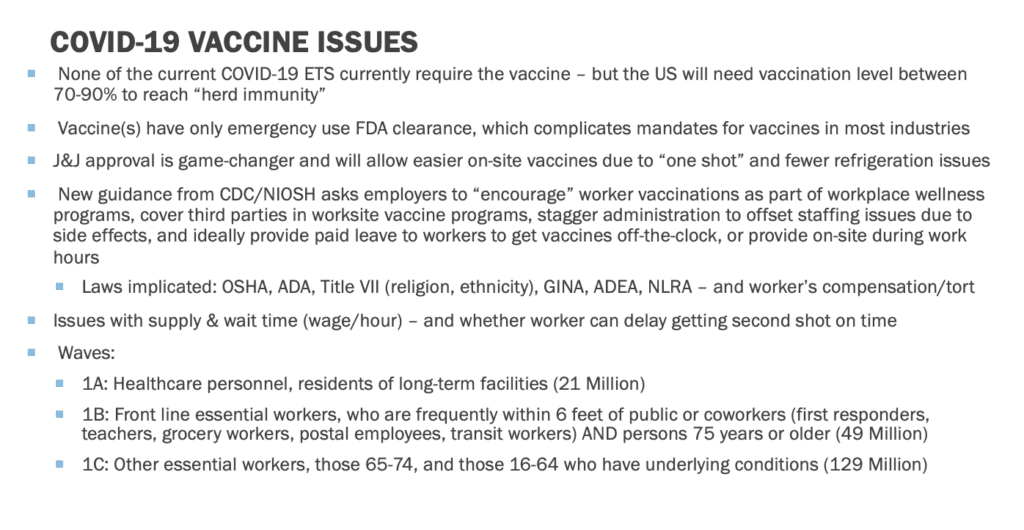
Curious about the vaccine distribution plan in your state? Check out NWRA’s Vaccine Distribution Tracker. Interested in learning more about the topics highlighted during this webinar? Listen to a recording of the webinar here.

